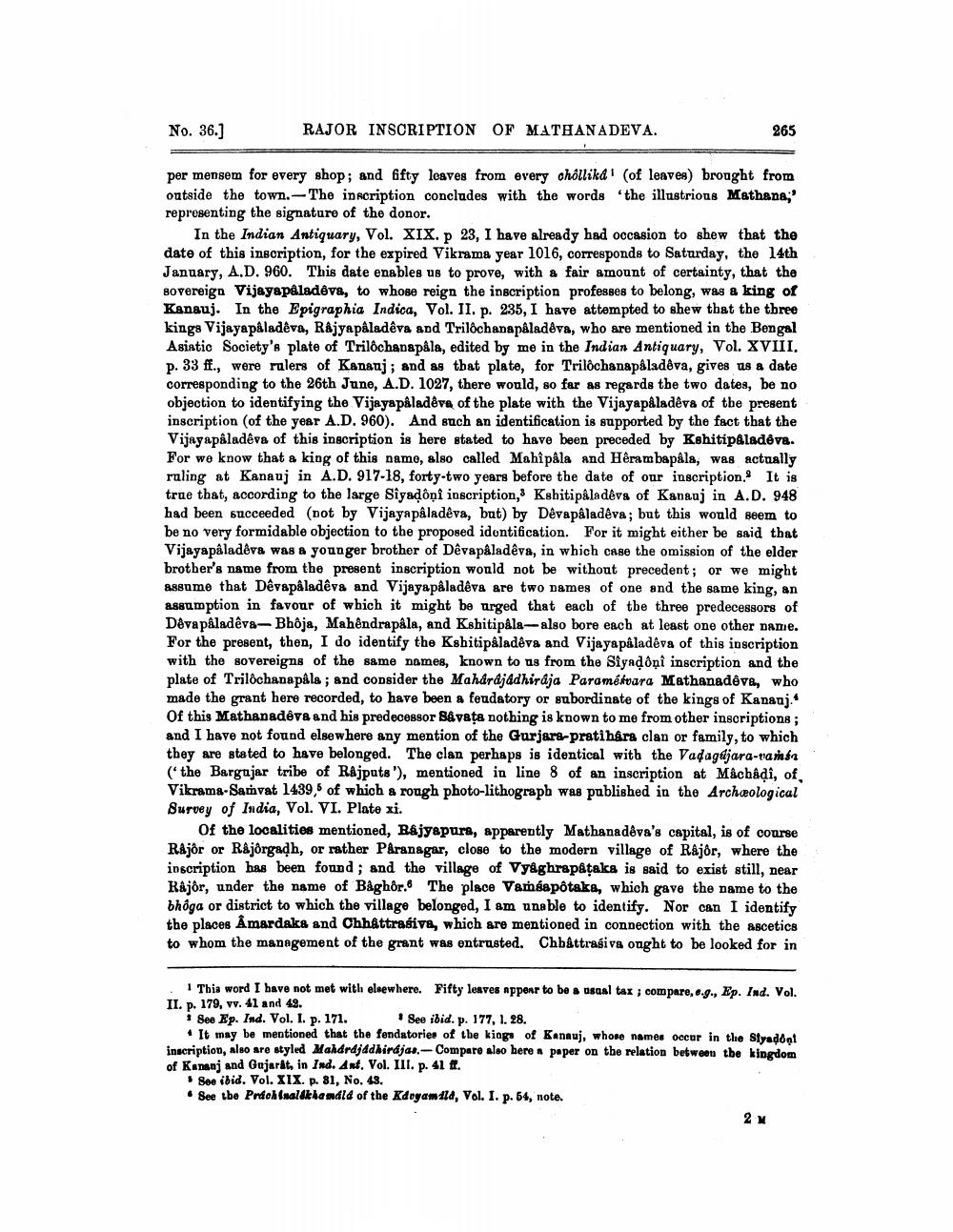________________
No. 36.]
RAJOR INSCRIPTION OF MATHANADEVA.
265
per mensen for every shop; and fifty leaves from every chóllika' (of leaves) brought from ontside the town.-The inscription concludes with the words the illustrious Mathana,' representing the signature of the donor.
In the Indian Antiquary, Vol. XIX. p 23, I have already had occasion to shew that the date of this inscription, for the expired Vikrama year 1016, corresponds to Saturday, the 14th January, A.D. 960. This date enables us to prove, with a fair amount of certainty, that the sovereign Vijayapaladva, to whose reign the inscription professes to belong, was a king of Kanauj. In the Epigraphia Indica, Vol. II. p. 235, I have attempted to shew that the three kings Vijayapåladeva, Rajyapaladêva and Trilochanapåladeva, who are mentioned in the Bengal Asiatic Society's plate of Trilôchapapala, edited by me in the Indian Antiquary, Vol. XVIII. p. 33 ff., were rulers of Kananj; and as that plate, for Trilochanapaladêva, gives us a date corresponding to the 26th June, A.D. 1027, there would, so far as regards the two dates, be no objection to identifying the Vijayapåladeva of the plate with the Vijayapåladeva of the present inscription of the year A.D. 960). And such an identification is supported by the fact that the Vijayapåladeva of this inscription is here stated to have been preceded by Kshitipaladeva. For we know that a king of this name, also called Mahipala and Heram bapala, was actually ruling at Kanauj in A.D. 917-18, forty-two years before the date of our inscription. It is true that, according to the large Siyadoni inscription, Kshitipåladeva of Kananj in A.D. 948 had been succeeded (not by Vijayapâladeva, but) by Dêvapâladeva; but this would seem to be no very formidable objection to the proposed identification. For it might either be said that Vijayapaladeva was a younger brother of Dêvapåladêva, in which case the omission of the elder brother's name from the present inscription would not be without precedent; or we might assume that Dêvapaladeva and Vijayapêladeva are two dames of one and the same king, an assumption in favour of which it might be arged that each of the three predecessors of Déva påladeva-Bhoja, Mahendrapala, and Kshitipala-also bore each at least one other name. For the present, then, I do identify the Kshitipåladêva and Vijayapâladêva of this inscription with the sovereigns of the same names, known to us from the Siyadoni inscription and the plate of Trilochanapala ; and consider the Maharajadhiraja Paramétvara Mathanadêva, who made the grant here recorded, to have been a feudatory or subordinate of the kings of Kananj." Of this Mathanadhva and his predecessor Såvaţa nothing is known to me from other inscriptions ; and I have not found elsewhere any mention of the Gurjara-pratihara clan or family, to which they are stated to have belonged. The clan perhaps is identical with the Vadagdjara-tanin ('the Bargujar tribe of Rajputs'), mentioned in line 8 of an inscription at Mâchâại, of Vikrama-Samvat 1439, of which & rough photo-lithograph was published in the Archeological Survey of India, Vol. VI. Plate xi.
Of the localities mentioned, B&jyapura, apparently Mathanadáva's capital, is of course Rájör or Rajòrgadh, or rather PAranagar, close to the modern village of Rajôr, where the inscription has been found; and the village of Vyaghrapätaks is said to exist still, near Rajør, under the name of Baghôr. The place Vamsapotaka, which gave the name to the bhôga or district to which the village belonged, I am unable to identify. Nor can I identify the places Amardaks and Chhattrašive, which are mentioned in connection with the ascetics to whom the management of the grant was entrusted. Chbåttragiva onght to be looked for in
Tbia word I have not met with elsewhere. Fifty leaves appear to be s usual tar; compare, 6.9., Ep. Ind. Vol. II. p. 179, vv. 41 and 42. * See Ep. Ind. Vol. I. p. 171.
See ibid. p. 177, 1. 28. It may be mentioned that the fondatories of the kings of Knauj, whose names occur in the Styadont inscription, also are styled Mahdrdjddhirdjas. - Compare also bere a paper on the relation between the kingdom of Kansoj and Gujarat, in Ind. Ant. Vol. III. p. 41 .
See ibid. Vol. XIX. p. 81, No. 43. • See tbe Pndohnallkhandld of the Kdoyam dia, Vol. I. p. 54, note.
2 x




